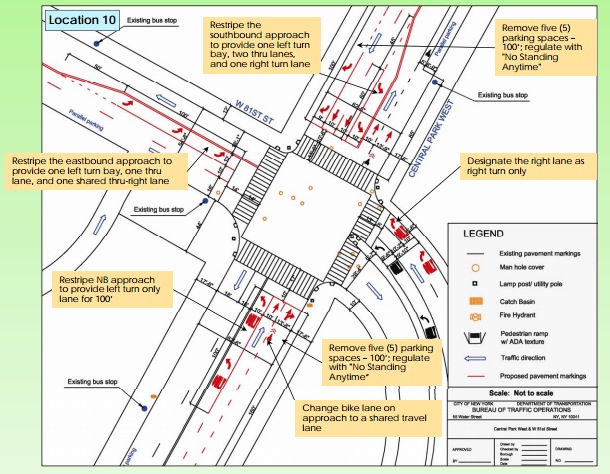
The Department of Transportation has completed a multi-year transportation study of the Upper West Side, and Wednesday night the agency walked local residents through the many proposed changes [PDF]. The suggestions for the area between 55th and 86th Streets, west of Central Park, include a number of valuable intersection-level improvements to pedestrian safety, but left some feeling that the recommendations don't go far enough.
Locals hoping to expand the protected bike lane network on the Upper West Side beyond the current mile of cycle track on Columbus Avenue were initially disappointed; the West Side study doesn't so much as mention new bike lanes. When pressed on the issue during the Q&A, however, DOT reps gave residents looking to expand the bike lane's safety benefits cause for optimism. "We are interested in increasing the bike network in this community," said DOT Borough Commissioner Margaret Forgione.
Forgione said DOT is finishing up a final evaluation of the existing Columbus Avenue bike lane and plans to show the new data to the local community board. Then, she said, DOT wants "to have the board help define where we go next." The two options she mentioned Wednesday were extending the Columbus Avenue lane and creating a northbound match on Amsterdam.
Included in last night's presentation were a host of smaller safety improvements. "This is not the sexiest," warned Council Member Gale Brewer, who provided the original impetus for the study.
Two striped islands on West End Avenue at 58th and 59th Streets would be converted into concrete refuge islands, for example, to provide real physical protection to crossing pedestrians.

Three neckdowns would be built at the corner of West End and 70th Street, two at the corner of 72nd and Riverside, and one each at the corners of 79th and Broadway and 79th and Riverside. During the Q&A, new CB 7 chair Mark Diller announced his support for those measures, calling himself "a new convert to these curb extensions."
On two Upper West Side blocks, DOT proposes using paint to narrow the street by one lane, in an attempt to calm speeding traffic. The "channelization" treatment would be put in place between West End and Amsterdam on 66th and 70th Streets.
And in five locations, new leading pedestrian intervals will improve signal timing, allowing people a chance to get into the crosswalk before turning traffic starts moving.
The safety improvements won cheers from locals who have been fighting for such measures for years. "We are obviously very supportive of your proposed recommendations," said Shauna Fitzgibbons, of the PS 199 PTA. She said she hoped to see the improvements on 70th Street and West End, where the school is located, implemented as quickly as possible.
DOT also plans to widen the entrances to the Broadway malls -- the pedestrian islands that run in the median on the Upper West Side. Currently, the entrances are so narrow that at busy intersections, many people opt to walk in the street rather than wait to filter onto the islands. DOT plans to expand the entrances to the malls from five feet wide to seven or nine feet.
At other points, however, the transportation study appeared more focused on making it easier to drive around the Upper West Side than on improving safety or sustainability. Last night's presentation began with a lengthy discussion of the vehicular level of service ratings in the study area -- a metric often used to justify anti-pedestrian road widenings -- and that perspective shows in some of the recommendations.

Where the Central Park transverses emerge at 81st and 86th Streets, for example, DOT's emphasis was squarely on reducing congestion. There, DOT proposes adding new turn lanes in all directions. To make room for the turns, the agency suggests removing on-street parking spaces and turning the existing painted bike lane into sharrows at the two intersections. Forgione admitted that the sharrows aren't as good for cyclists as painted lanes.
One recommendation that will be good for safety and congestion alike -- the creation of new commercial parking spaces along Columbus and Amsterdam Avenues -- earned grumbles from residents who wanted curb parking for themselves. "Get the trucks out of the travel lane and at the curbside, where they really belong," said Forgione. Currently, there are almost no commercial parking spaces in the study area, despite significant retail activity, leading to constant double-parking.
More than one Upper West Sider suggested that every lost parking space was part of an effort to eliminate cars from New York City altogether. "It seems to me that all proposals remove parking," complained one woman. "Either there are no cars in New York City or because there are cars in New York City, you have to deal with it."
All the individual proposals will go before the community board, said Forgione.
Many in the room felt that the recommendations were awfully small-bore for a study that's been underway since 2007 and was uniquely situated to look at transportation issues area-wide, rather than intersection by intersection. Many residents wanted to address the West Side Highway and the possibility of reopening the now-shuttered 72nd Street exit, or of allowing truck traffic on the parkway sections of the road. Others pressed the question of bike infrastructure.
"I think it lacks real creativity and vision," said Upper West Side Streets Renaissance organizer Lisa Sladkus. "Adding truck loading is a good thing. Using curb extensions are a good thing. Adding LPIs are a good thing. A lot of that stuff is good, it's just not that inspiring. That's a disappointment."





